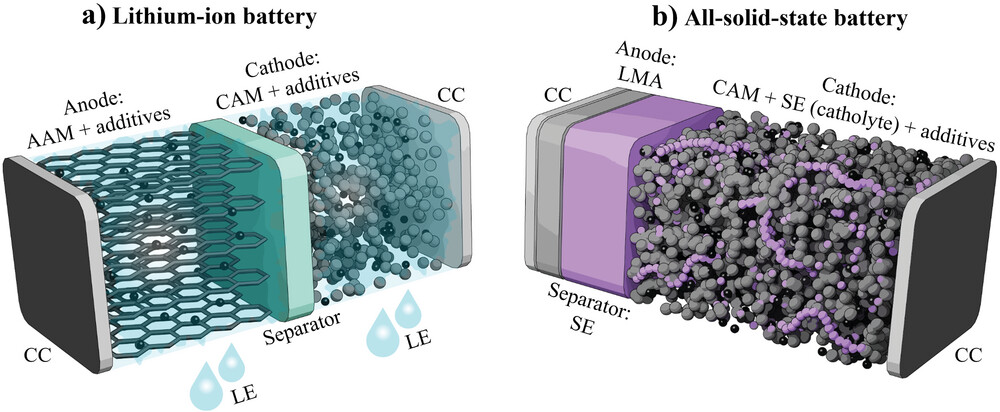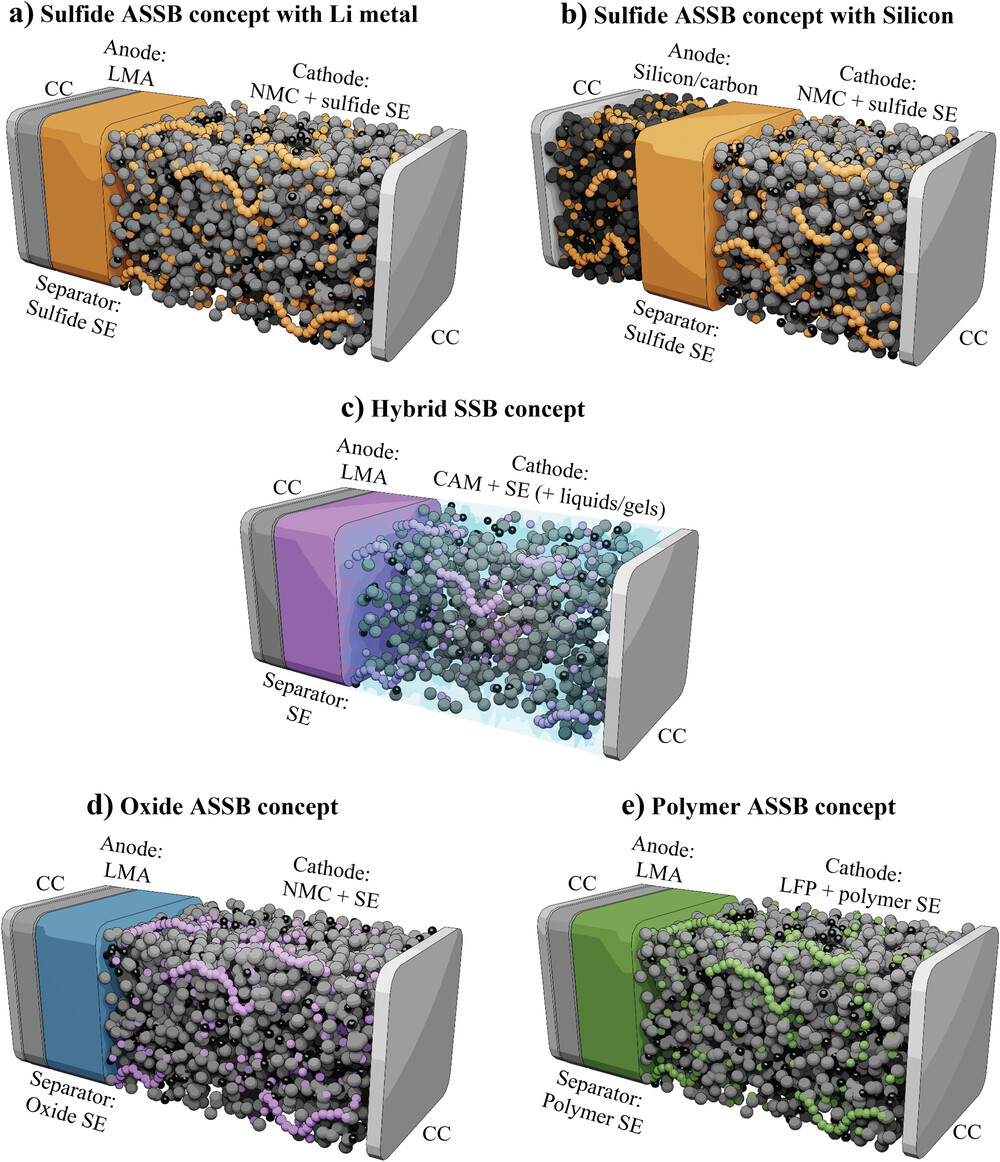| Nov 19, 2023 |
|
|
|
(Nanowerk Spotlight) The lithium-ion battery has become ubiquitous in our daily lives, powering everything from smartphones to electric vehicles. Yet as demand grows for batteries with higher energy density, faster charging times, improved safety and lower costs, researchers continue to push the boundaries of battery chemistry and design.
|
|
In a new Perspective paper published in Advanced Energy Materials (“A Roadmap for Solid-State Batteries”), scientists from the Fraunhofer Institute for Systems and Innovation Research and Justus Liebig University map out the development trajectory for one of the most promising next-generation battery technologies – the solid-state battery.
|
 |
| Graphic illustrations of a) a state-of-the-art lithium-ion battery with liquid electrolyte and b) an all-solid–state battery with lithium metal anode. (CC: current collector; LE: liquid electrolyte, SE: solid electrolyte; AAM/CAM: anode and cathode active material, respectively; LMA: lithium metal anode). (Reprinted with permission by Wiley-VCH Verlag)
|
|
For over three decades, innovations in lithium-ion batteries have steadily improved their performance. But fundamental limitations of their liquid electrolytes – the medium that transports lithium ions between the anode and cathode – have become roadblocks to further progress.
|
|
Flammable liquid electrolytes present safety risks, especially as higher energy densities are pursued. They also limit the viable materials for the anode. Graphite dominates commercial lithium-ion batteries today, but new high-capacity anode materials like lithium metal and silicon could enable major leaps in energy density if paired with a non-flammable solid electrolyte.
|
|
Ditching the liquid for a solid would remove flammability concerns, enable the use of lithium metal or silicon anodes, and open up new possibilities for battery optimization. But finding the right solid electrolyte materials has proven difficult.
|
|
“An ideal single solid electrolyte combining high room-temperature ionic conductivity with wide electrochemical stability does not exist yet,” explains Dr. Thomas Schmaltz, a senior scientist at Fraunhofer ISI and co-author of the paper. “The challenge is combining all the desired properties into one material.”
|
|
This has led researchers to explore hybrid solid electrolyte systems that blend the advantages of different compounds into a composite material. The Fraunhofer and Justus Liebig scientists lay out a roadmap for development based on three main solid electrolyte material classes: polymers, sulfides and oxides.
|
|
Each category has trade-offs. Polymers offer better elasticity but falter on ionic conductivity at room temperature. Sulfides ace on conductivity but have narrow electrochemical stability. Oxides flaunt wide stability but lack conductivity. Clever combinations of these materials emerge as a promising path to engineer an optimal solid electrolyte.
|
|
“Replacing the liquid electrolyte on the cathode side with a solid is the bigger challenge,” says Dr. Jürgen Janek, Director of the Center for Materials Research at Justus Liebig University and co-author of the study. “To compete with lithium-ion batteries, the solid cathode electrolyte in a high-performance solid-state battery needs ionic conductivities over 10 mS/cm.”
|
That’s a tall order for any existing solid electrolyte material. But new material discovery and innovations in composite systems could get there soon. The researchers point to recent advances like the 2020 discovery of Li
2S-P
2S
5 glasses offering conductivities exceeding 10 mS/cm. More surprises might be in store.
|
|
The Fraunhofer and Justus Liebig experts don’t see solid-state batteries as a total battery revolution, but rather the next step in a gradual evolution. Early solid-state batteries will likely use similar cathode materials to today’s lithium-ion batteries.
|
|
“It’s quite possible the same cathode active materials used in lithium-ion batteries with liquid electrolytes are conceivable for or are already implemented in lithium-based solid-state batteries,” the researchers write.
|
|
But pairing those cathodes with lithium metal or silicon anodes enabled by solid electrolytes could drive significant leaps in energy density. Their roadmap shows solid-state batteries with lithium metal anodes and either sulfide or oxide solid electrolytes reaching pilot production between 2025 and 2030.
|
|
Prototypes demonstrating high charge rates, extended cycling and sufficient energy densities for electric vehicle applications have already been reported by companies like Toyota, Samsung SDI, SVolt and Solid Power.
|
 |
| Graphic illustrations of promising SSB cell concepts based on a) standalone sulfide SE (orange) with LMA, b) standalone sulfide SE (orange) with silicon anode, c) hybrid setup containing unspecified SE as catholyte and separator (violet), and depicting the trend to add certain amounts of liquids or gels (turquoise catholyte), d) oxide SE separator (blue) with non-oxide catholyte (unspecified, violet), and e) standalone polymer SE (green) with LMA. (CC: current collector; SE: solid electrolyte; CAM: cathode active material; LMA: lithium metal anode; NMC: LiNi1−x−yMnxCoyO2; LFP: LiFePO4.) (Reprinted with permission by Wiley-VCH Verlag)
|
|
More incremental steps include hybrid solid–liquid batteries that incorporate a small amount of liquid electrolyte to aid conduction and interfacial contact. These compromise a bit on safety but improve manufacturability. The researchers anticipate hybrid concepts achieving notable production scale in the next few years as an interim solution.
|
|
But all-solid-state lithium metal batteries remain the long-term goal. These face daunting manufacturing hurdles at mass market scale along with unanswered science questions around dendrite suppression and electrolyte adhesion.
|
|
Still, developments are rapid. “The industry is now moving fast, with announcements for a production capacity of almost 300 GWh already made,” the researchers observe.
|
|
They don’t expect solid-state batteries to immediately displace lithium-ion but see them steadily gaining market share over the next decade. With continued research progress, manufacturing advances and disciplined engineering, solid-state batteries are poised to become the high-energy heir to today’s lithium-ion throne.
|
|

By
Michael
Berger
– Michael is author of three books by the Royal Society of Chemistry:
Nano-Society: Pushing the Boundaries of Technology,
Nanotechnology: The Future is Tiny, and
Nanoengineering: The Skills and Tools Making Technology Invisible
Copyright ©
Nanowerk LLC
|
|
|
- SEO Powered Content & PR Distribution. Get Amplified Today.
- PlatoData.Network Vertical Generative Ai. Empower Yourself. Access Here.
- PlatoAiStream. Web3 Intelligence. Knowledge Amplified. Access Here.
- PlatoESG. Carbon, CleanTech, Energy, Environment, Solar, Waste Management. Access Here.
- PlatoHealth. Biotech and Clinical Trials Intelligence. Access Here.
- Source: https://www.nanowerk.com/spotlight/spotid=64070.php






